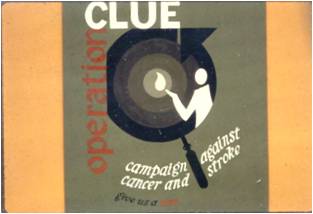The CLUE Studies
The CLUE studies include two large cohorts of volunteers who donated blood in 1974 and 1989.
These studies provide an excellent foundation for innovative research using existing data, stored specimens and medical chart review.
New projects proposing the use of specimens are initiated by completing the ancillary proposal form. New papers using exisiting data should be initiated using the manuscript proposal form.
CLUE I - Campaign Against Cancer and Stroke

Serologic Precursors of Cancer was conducted in Washington County, Maryland, in the fall of 1974 with funding from the National Cancer Institute. A blood sample was collected from 26,147 individuals (23,951 were residents of Washington County) at the time of participation. Mobile office trailers were used, operating in all areas of the county. Brief health histories and blood pressures were taken and 15 ml of blood was drawn. Blood samples have been stored at -70 C since collection. Comparisons with published figures from the 1980 Census indicated that approximately 30 percent of adult residents had participated. Women, Caucasians and the better-educated had higher participation rates, as did the age group 45 to 70 years. The Clue Cohort, like those utilized in most observational or experimental studies are a select group of the general population, namely volunteers. The cohort is community-based with reasonable representation of the general county population, with substantial heterogeneity of risk factors for disease outcomes.
CLUE II - Campaign Against Cancer and Heart Disease

The Campaign Against Cancer and Heart Disease is an outgrowth of CLUE I, and was also funded by a grant from the National Cancer Institute. CLUE II was conducted from May through October, 1989. A blood sample was collected from 32,894 individuals (25,076 were residents of Washington County). As in CLUE I, mobile office trailers were used and 20 ml of blood was drawn into 20 ml vacutainers. In addition to providing a brief health history, participants were given a food frequency questionnaire to complete at home and were asked to return it with a toenail clipping for trace metal assays. In addition to plasma, white blood cells and a sample with a vitamin C preservative added for future studies of ascorbic acid were stored at -70 C. As in CLUE I, comparisons with published figures from the 1990 Census indicted that approximately 30 percent of adult residents had participated. Again, women, Caucasians and the better-educated had higher participation rates, as did the age group 45 to 70 years.
- CLUE II - Baseline Questionnaire - 1989
- CLUE II - Food Frequency/Diet Questionnaire - 1989
- Number of Self-Reported Cases with Extracted DNA
- Cancer Registry Counts
- Major Underlying Cause of Death in CLUE Population
Odyssey Cohort
The Odyssey cohort involves approximately 8,394 persons who participated in CLUE I and CLUE II, to examine the effects of the interaction of genes and environmental exposure on cancer, health and aging.
Active Follow-up Of CLUE Participant
In order to use the resources of the specimen bank to its fullest potential, additional data was collected. Self-administered mailed questionnaires were sent to participants in 1996, 1998, 2000, 2003 and 2007. Questions were asked regarding family history, medical conditions, medication, vitamin use and exercise, among others.
